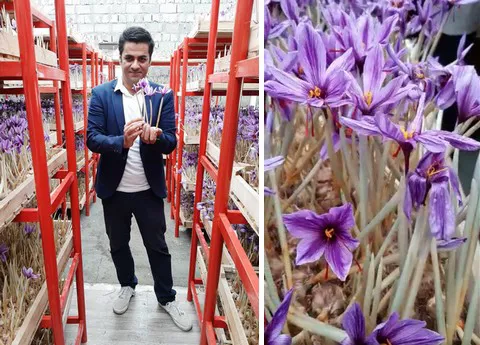Iran is responsible for most of the global saffron cultivation and they're proud of being the global supplier of what is known as the most expensive spice in the world. Since it's a super expensive product, there's a lot of interest in ways to increase the production or decrease the loss in growing. You might have guessed: growing indoors offers opportunities. Ardalan Ghilavizadeh, Sr agronomist, shares his insights on growing saffron indoors.

Saffron growers are all in one: they grow the saffron flowers from bulbs and also have to process the wet flowers in such a way that only the stigmata is dried and can be used for the spice. The whole process is extremely labor intensive and with labor costs rising all around the globe - also in Iran - it can easily become interesting to invest in ways to decrease the need for labor.
Ardalan Ghilavizadeh has been doing research on growing saffron indoors, in a vertical facility. He explains how the best time to harvest the outdoor grown saffron bulbs is in spring. "When they sleep, we transfer them for storing in 25 degrees, with a humidity of about 75 percent. To prevent diseases and damage done by insects, there's the possibility of choosing bigger bulbs," Ardalan shows. "About 25 grams or above are best. The bulbs are placed in wooden boxes for the humidity. To ensure flowering in the indoor facility, the temperature should be kept between 15 degrees Celsius during the day and 10 in the night time, something that's difficult to realise when growing outdoors. When growing indoors we can grow with artificial lights or with the light of the sun." In addition also the CO2 is controlled. "In the first phase it's kept at 600 ppm. Within two weeks the buds reach a height of 10 centimeter. One week later there's a flower, flourishing takes two more weeks."
"The quality of saffron grown indoors is better than outdoor cultivation since we control the temperature," Ardalan tells. "Than also disorder and diseases hardly occur on indoor grown crops and when they occur, we can control them easier than outdoors. This means that the quality of the crops is very high."
Yet the density and more important, the reduction of the required labor, are even bigger advantages. The team has spent many hours on finding the perfect density. "The density in indoor conditions can be optimised. In our hall of 60 meters we can grow 4 ton of saffron bulbs. Then every 70 kilogram of wet flowers gives 1 kilogram of dried crops, so you could say that each ton of saffron bulbs results in two kilogram of dried material. In the end it means that we can grow the same amount on 100m2 indoors as we grown on 1 hectare of outdoor cultivation."
In addition to saffron he's also active in mushroom growing - something that is of course done indoors as well. "And fodder can also be grown hydroponically and indoors. We see great opportunities for this in Iran."
